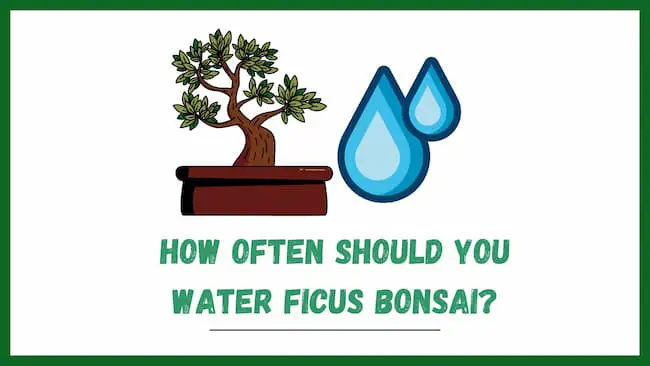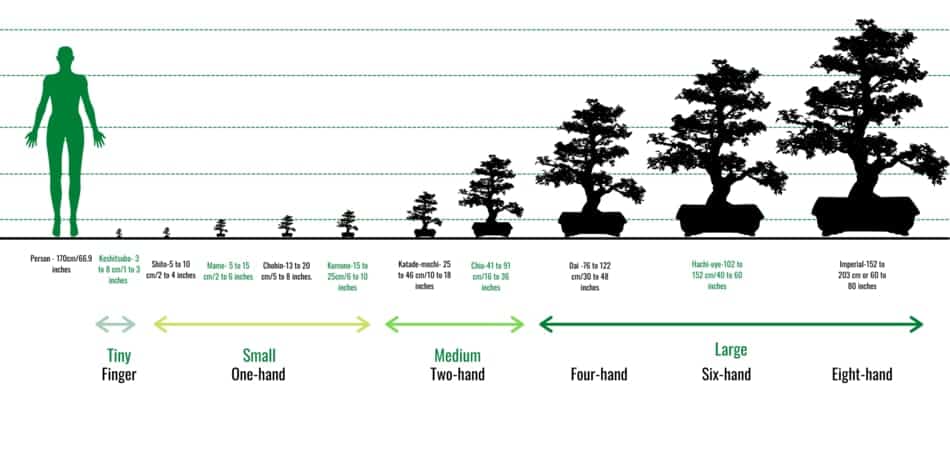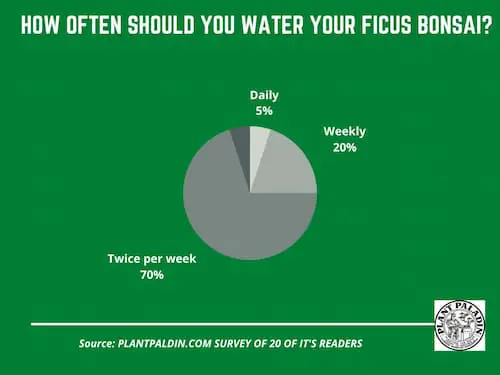This website is supported by its readers. If you click one of my links I may earn a commission. I am also a participant in the Amazon affiliates program and I will also earn a commission from qualified purchases.

With over 800 subspecies, ficus bonsai trees are easily the most popular indoor bonsai trees available. While the trees are usually straightforward to care for, it can be challenging to decide how often to water them, so how often should you water a ficus bonsai tree?
Regardless of subspecies, ficus bonsai trees should be watered once to twice weekly when the topsoil is dry. Daily misting can be undertaken to ensure the tropical tree stays humid; however, do not overwater, as this can lead to fungal issues.
So do you need to water different ficus bonsai species differently? And what type of water works best when watering your ficus bonsai tree? Keep reading to find out more!
Just a quick heads up, over the past three years of running Plantpaladin, hundreds of people have asked for product recommendations. As such, You can find my favorite indoor bonsai tree here (link takes you to Bonsaiboy), my favorite outdoor bonsai tree (link takes you to Bonsaiboy), or have a look at all the products I recommend here.
How often should you water a ficus bonsai tree?
So ficus bonsai trees are historically easygoing indoor bonsai trees. It’s one of the main reasons why they are perfect for beginners.
That said, the advice around watering ficus bonsai trees can be confusing.
I know when I first started my bonsai journey, I struggled with this.
As such, I contacted a few bonsai experts, visited my local botanical gardens, and even surveyed 20 plant paladin readers.
All to understand how often you should water a ficus bonsai.
To summarize:
- Most ficus bonsai tree species will only need to be watered once/twice per week.
- This is because the tree is tropical and grown natively in humid conditions, such as in China and Japan.
- As such, the tree can tolerate less watering than other varieties, such as willow bonsai trees.
- Ensure that you only water the ficus bonsai tree when the topsoil is relatively dry, and avoid it if it is moist.
- General misting can be undertaken daily during warmer conditions.
- You will, however, need to check your Ficus for water during the warm summer months more often – at least twice per day to prevent your tree from drying out.
- There is no real difference in the ficus sub-species. Despite having over 800 sub-species, most of the ficus varieties used in bonsai can follow this advice.
- Water your ficus bonsai tree with a watering can, hosepipe, or misting. Consider using a humidity tray or bottom watering if you are away from your ficus bonsai for prolonged periods.
- You can also add moss to your bonsai tree to add moisture to your ficus bonsai.
So now we know the quick facts about watering your ficus bonsai, let’s dive into slightly more detail on the specifics.

How do I know if my ficus bonsai needs watering?
The most surefire way to know your focus bonsai needs watering is to place your index finger one to two inches in the topsoil. If the topsoil is dry, water your ficus tree until the water pours out the drainage holes. Typically you will water your ficus bonsai 1 to 3 times per week.
So first, before you use any water to water your Ficus, we must figure out if your tree needs watering.
Now if you are a beginner, this can be challenging, especially if you are used to watering regular houseplants.
Fret no, however, as the process is super easy.
To check if your ficus bonsai tree needs watering, press your finger in the topsoil of your bonsai tree until it is about 2 to 3cm deep.
If the soil is relatively dry, then your Ficus needs watering.
That’s it – super simple.
If the soil is relatively moist, leave watering your ficus bonsai till the next day.
As a general rule of thumb, ficus bonsai trees in most mild conditions must only be watered once to twice weekly.
As such, I generally check if my Ficcus bonsai trees need watering once in the morning.
During warmer conditions, however, such as the middle of summer, I like to check if my ficus bonsai trees need watering twice daily ( in the morning and evening) simply because excessive heat can cause the ficus bonsai to dry out fast.
How to water your ficus bonsai tree?
So we know our ficus bonsai tree needs watering – how do we do it?
Well, watering your bonsai tree is super easy, and the good news is that there are a few quick methods that you can follow.
These include
- Using a watering can
- Using a hosepipe
- Spritzing with a spray bottle
- Bottom watering
Let’s break these down in more detail:
Using a watering can
So the most common method to water your ficus bonsai is to use a watering can.
It’s the most beginner friendly and will ensure good coverage across your tree.
To do so, attach the spray nozzle to your watering can so you do not have one solid stream of water but a sprinkle of water.
Move your Ficus bonsai outdoors or to where the water can flow freely underneath the tree.
Then pour the water directly over the leaves of the ficus bonsai. Water from the leaves will pour out through the drainage holes of the tree.
Aim to water your tree, depending on the size, for 20 to 40 seconds.
You will have completed watering the tree when the water has started to pour out from the bottom drainage holes.
Use a hosepipe
Using a hosepipe for your ficus bonsai tree can be more challenging, depending on how powerful your hosepipe is.
Using the low-pressure function will ensure you do not damage your tree with a big blast of water.
I would only opt for the high-pressure function if you had an insect infestation on your tree, such as Aphids, and wanted to blast them away.
I’d also attach the spray nozzle to your hosepipe to prevent your tree from getting hit with one solid stream of water and instead has an even excellent distribution.
Mist with a spray bottle
As Ficus bonsai trees are used in warm but humid environments, misting can be recommended for use on your focus bonsai tree.
Move to an outdoor space or space where you won’t damage your surrounding area with water.
Then fill up your mister with room temperature soft water and thoroughly spray the leaves and branches of your Ficus bonsai tree.
You can mist your ficus bonsai much more frequently; I’ve misted my ficus bonsai daily in the past without any real issues.
Bottom watering
Finally, consider using bottom watering or moisture trays if you are on vacation or away from your bonsai trees for a significant period and don’t have anyone to look after your trees.
To bottom water, fill a bucket full of room temperature soft water.
Then gently palace the pot into the bucket until the base is covered.
Do not submerge the entire pot underwater, as this will lead to overwatering; you want to endure the bottom drainage holes being coved.
Alternatively, fill a thin shallow moisture tray with water and gently place your ficus bonsai tree there.
What type of water should you use to water your ficus bonsai tree?
Use filtered, soft water for the best results when watering your ficus bonsai tree. This will best replicate rainwater from where ficus trees are naturally grown. Avoid using regular tap water, which can contain excess calcium.
Now I’ve written an entire post about the best types of water to water your bonsai tree.
That said, you generally want to stick to either filtered or rainwater and aim for soft water to ensure it does not strip back the nutrient of your tree soil.
Alternatively, regular tap or bottled water will contain contaminants such as microplastics and excess calcium that can damage your tree.
I’ve created a table below showing the different types of water and their rating out of ten when watering your ficus bonsai.
Water type | Rating (out of 10) |
Rainwater | 10 |
Filtered Water | 8 |
Distilled water | 5 |
Tap water | 5 |
Mineral/spring water | 5 |
Pondwater | 5 - 7 depending on tree species |
Fruit juices, cola other soft drunks | 2 |
How much water should you use to water your Ficus bonsai?
So while I mentioned earlier that you should typically water your ficus bonsai for about 20 to 40 seconds, finding the perfect amount of water that keeps your tree refreshed but does not overwater can be challenging.
Having had a few years under my belt, I’ve discovered that the larger your bonsai tree, the more water you will need.
For example, smaller-sized fingertip-style bonsai trees only need 200-300ml when watering.

However, more giant imperial-sized bonsai trees will need one to two liters.
To help, I’ve created a table below:
Classification | Size inches | Size Centimeters | Hand size | General size | How often should you water |
Keshitsubo | 1 to 3 inches | 3 to 8 centimeters | Fingertip | Tiny | Every 2 days |
Shito | 2 to 4 inches | 5 to 10 centimeters | One-hand | Tiny | Every 2 days |
Mame | 2 to 6 inches | 5 to 15 centimeters | One-hand | Small | Every 2 days |
Chohin | 5 to 8 inches | 13 to 20 centimeters | One-hand | Small | Every 3 days |
Kumono | 6 to 10 inches | 15 to 25 centimeters | One-hand | Small | Every 3 days |
Katade-mochi | 10 to 18 inches | 25 to 46 centimeters | Two-hand | Medium | Every 4 days |
Chiu or Chumono | 16 to 36 inches | 41 to 91 centimeters | Two-hand | Medium | Every 4 days |
Dai or Omono | 30 to 48 inches | 76 to 122-centimeters | Four-hand | Large | Every 5 days |
Hachi-uye | 40 to 60 inches | 102 to 152 centimeters | Six-hand | Large | Every 6 days |
Imperial | 60 to 80 inches | 152 to 203 centimeters | Eight-hand | Large | Weekly |
How often should you water a ficus bonsai tree by species?
So while we have covered the basics of watering your Ficus bonsai tree already, as I mentioned, there are over 800 sub-species of Ficus that can be used.
So is there a difference in watering the different species?
There are no fundamental differences between different ficus bonsai sub-species regarding watering. All ficus bonsai trees must only be warted once to twice weekly when the topsoil is dry.
Now while there are over 800 sub-species, I’ve listed the five most common species below, as well as how often you should water them:
Species | Frequency | How deep do you need to push your finger to check |
Ficus Benjamina | Once to twice per week | Place your finger one to two inches deep |
Ginseng Ficus | Once to twice per week | Place your finger one to two inches deep |
Ficus Retusa | Once to twice per week | Place your finger one to two inches deep |
Ficus Microcarpa | Once to twice per week | Place your finger one to two inches deep |
It’s also worth noting how often you need to water ficus bonsai trees compared to other bonsai species, just in case you have an extensive bonsai collection.
As such, I’ve compiled a table below that should help!
How often should you water a bonsai by species – table?
Bonsai Species | How often should topsoil be checked | How often should the bonsai tree be watered |
Weeping Willow | A few times per day | Daily |
Birch | A few times per day | Daily |
Alder | A few times per day | Daily |
Apple | Once per day | A few times per week when not producing fruit. Daily when producing fruit. |
Lemon | Once per day | A few times per week when not producing fruit. Daily when producing fruit. |
Lime | Once per day | A few times per week when not producing fruit. Daily when producing fruit. |
Orange | Once per day | A few times per week when not producing fruit. Daily when producing fruit. |
Crabapple | Once per day | A few times per week when not producing fruit. Daily when producing fruit. |
Cherry | Once per day | A few times per week when not producing fruit. Daily when producing fruit. |
Ficus | Once per day | Daily to a few times per week. |
Chinese Elm | Once per day | Daily to a few times per week. |
Fukien Tea | Once per day | Daily to a few times per week. |
Serissa | Once per day | Daily to a few times per week. |
Olive | Once per day | Daily to a few times per week. |
Juniper | Once per day | Daily to a few times per week. |
Pine | Once per day | Daily to a few times per week. |
Scots Pine | Once per day | Daily to a few times per week. |
Oak | Once per day | Daily to a few times per week. |
Jade | Once per day | Daily to a few times per week. |
How long can Ficus bonsai go without water?
Ficus trees should not be left without water for more than two weeks. At this point, the tree will start to decay. Wilting leaves, dry, brittle branches, and poor health indicate your ficus tree needs watering.
That said, ficus bonsai trees are incredibly resilient, meaning that if you forget to water your ficus bonsai tree for a short period (and do not do it too often), your ficus bonsai will recover.
This is because ficus bonsai trees are incredibly resilient. One of the reasons why they are so beginner friendly is that they’re pretty hard to kill.

Why is it important to water your ficus bonsai tree?
So now you know how to water your ficus bonsai tree, why is watering so important?
- Essential for survival: Water is essential for the survival of any plant, including bonsai trees. It provides the necessary hydration for the tree’s cells, allowing them to function correctly and carry out essential metabolic processes. Without sufficient water, the bonsai tree can become dehydrated and eventually die.
- Nutrient uptake: Water is a carrier for essential nutrients in the soil. Proper watering ensures that these nutrients are transported to the roots, where the bonsai tree can absorb them. The tree may need an adequate water supply to uptake nutrients, leading to nutrient deficiencies and poor growth.
- Growth and development: Watering influences the growth and development of the bonsai tree. It supports cell expansion, photosynthesis, and the production of new leaves and branches. Adequate moisture levels in the soil promote healthy root growth, allowing the tree to anchor itself and absorb nutrients effectively.
- Prevents wilting and stress: Insufficient watering can lead to wilting and stress in the bonsai tree. When a tree doesn’t receive enough water, it can’t maintain turgidity, causing the leaves to sag and the overall appearance of the tree to suffer. Providing adequate water help the tree maintain its vigor and prevent wilting.
- Temperature regulation: Watering can help regulate the temperature around the roots of the bonsai tree. During hot weather, evaporation of water from the soil cools down the surrounding area, preventing heat stress on the roots. It also helps to maintain a more stable root environment in fluctuating temperature conditions.
How often should you water your ficus bonsai by season?
Most of you reading this do not live in climates where temperatures stay the same year-round, but in mild temperate climates as I do, that change season to season.
As such, tracking how often you need to water your ficus bonsai tree as the season changes can be challenging.
To summarise, however, I’ve made a table below:
Season | Water requirements |
Spring | Daily to a few times per week. |
Summer | Multiple times per day to daily. |
Autumn | Daily to a few times per week. |
Winter | Once per week/every two weeks. |
Problems with overwatering your ficus bonsai tree?
Overwatering a ficus bonsai tree can lead to various problems and can negatively impact the health and well-being of the tree. Here are some issues that can arise from overwatering:
- Root rot: Excess water in the soil can saturate the root system, leading to oxygen deprivation. This creates a favorable environment for anaerobic bacteria and fungi growth, causing root rot. Root rot can damage or kill the roots, impairing the tree’s ability to absorb water and nutrients.
- Lack of oxygen: Overwatering can fill air pockets in the soil, displacing the oxygen vital for root respiration. Oxygen deprivation can suffocate the roots, leading to root dieback and the overall decline in the tree’s health.
- Nutrient deficiencies: When the soil is constantly waterlogged, it hampers the tree’s ability to take up nutrients effectively. Over time, this can result in nutrient deficiencies, causing yellowing leaves, stunted growth, and weakened overall vitality.
- Fungal and bacterial diseases: Excessive moisture provides an ideal breeding ground for fungal and bacterial pathogens. These pathogens can attack the weakened roots and foliage, causing diseases such as leaf spots, powdery mildew, or damping-off. These diseases can further weaken the tree and impact its aesthetic appeal.
- Leaf yellowing and drop: Overwatering can lead to soggy leaves, causing them to turn yellow and eventually drop prematurely. This can result in a sparse canopy and detract from the bonsai’s overall beauty.
Problems with underwatering your ficus bonsai tree
Underwatering a ficus bonsai tree can also lead to several issues and negatively impact its health and development. Here are some problems that can arise from under-watering:
- Dehydration: Lack of sufficient water can lead to dehydration in the bonsai tree. As the tree dehydrates, its leaves may wilt, dry, and eventually wither. Severe dehydration can cause irreversible damage and even tree death if not addressed promptly.
- Stunted growth: Adequate water is essential for the growth and development of a ficus bonsai tree. Underwatering can hinder the tree’s ability to carry out essential metabolic processes, resulting in stunted growth and a lack of vigor. The tree may need help producing new leaves and branches, leading to a poor aesthetic appearance.
- Nutrient uptake issues: Water is a carrier for essential nutrients in the soil. More watering must be needed to ensure the tree can absorb nutrients effectively, leading to nutrient deficiencies. This can manifest as yellowing leaves, poor foliage color, and weakened overall health.
- Root damage: Underwatering can cause the roots of the bonsai tree to dry out and become brittle. This can lead to root damage, including root dieback or root desiccation. Damaged roots are less able to absorb water and nutrients, further exacerbating the problem.
- Increased susceptibility to stress and pests: Underwatered ficus bonsai trees are more prone to stress from environmental factors such as heat, intense sunlight, or low humidity. They are also more susceptible to pest infestations, as weakened trees can less defend themselves against pests and diseases.
Is there a specific time of day you should water your ficus bonsai?
Now the time of day you water your ficus bonsai will be entirely up to you and when is convenient.
That said, a few rules I like to stick by are:
- Try to water simultaneously to ensure your bonsai has even hours before its next watering session.
- Aim to water in the morning during warm conditions to check if your tree needs watering in the afternoon.
- Water during the brightest part of the winter day to prevent your ficus bonsai from freezing.
What is the best location to water your ficus bonsai?
Watering a ficus bonsai outdoors on a flat surface is the best location to water a ficus bonsai. Outdoor watering will allow any excess water to drain evenly from your bonsai pot without the worry of pools of water building up.
While you can water your ficus tree indoors (after all, it is down to a matter of preference and convince), moving my Ficus outdoors when watering makes for a much cleaner approach.
Does Ficus bonsai prefer bottom or top watering?
Like most bonsai trees, ficus bonsai prefers top watering via a watering can, spritzer, or hosepipe rather than bottom watering via a moisture tray or bucket. This is because there is a much more significant chance of overwatering the bonsai with bottom watering.
Can you use moss to help water ficus bonsai?
Now one trick I’ve developed over the past few years if traveling is to use mosses such as sphagnum moss to help water my ficus bonsai.
Mosses can absorb over eight times their weight in water and provide a steady, stable stream of water to your tre if you cannot water it.
Place the moss on the tree’s topsoil or trunk for this benefit.
How often should you water a ficus bonsai? Survey results
Finally, as mentioned, I surveyed 20 plant paladin readers, asking them how often they water their ficus bonsai trees.
To summarize:

My top picks for the gear you will need!
So like I mentioned earlier, over the past three years of running PlantPaladin, hundreds of people have asked me for my recommendations on the best bonsai gear on the market.
Having spent thousands of dollars on bonsai items these past few years and tested at least 100 bonsai-specific products, I’ve listed my favorite products below – All of which I highly recommend and think you can get great value.
They can purchase directly by clicking the link to take them to Amazon.
Bonsai Tool Set: One of the significant challenges I’ve had is finding a toolset that was not only durable but didn’t break the bank. SOLIGT has recently developed a fantastic bonsai tool set that covers all the tools you need to trim, prune, and repot your trees. – You can grab it here.
Complete Bonsai Set: Many of you will want to grow your bonsai trees entirely from scratch, but finding the varicose seeds, pots, and other items in one place can be challenging. Leaves and Sole then have created a complete bonsai set that I’ve personally used that ticks all the boxes. You can grab it here.
Bonsai wire: The number of times I’ve run out of wire for my bonsai or purchased cheap bonsai wire that doesn’t do the job is embarrassing for me to admit. After a lot of trial and error, I found that using Hotop’s aluminum bonsai wire is one of the best options on the market. This can easily be used for both indoor and outdoor bonsai. You can grab it here.
This post was written by Fehed Nicass, who has been passionate about bonsai and gardening for over three years.
